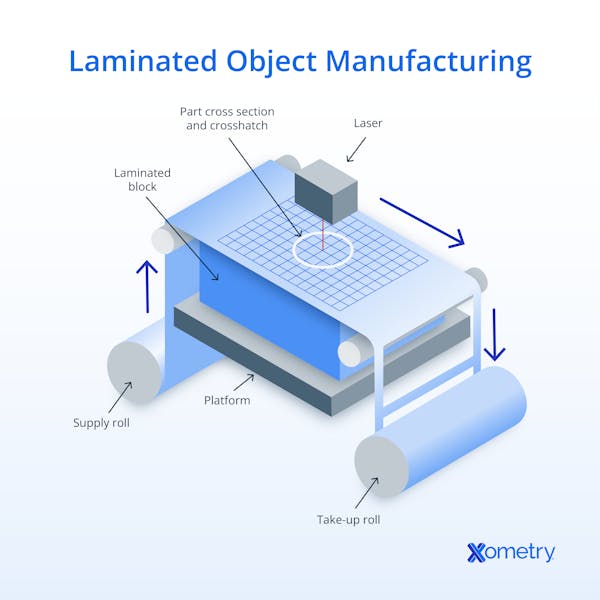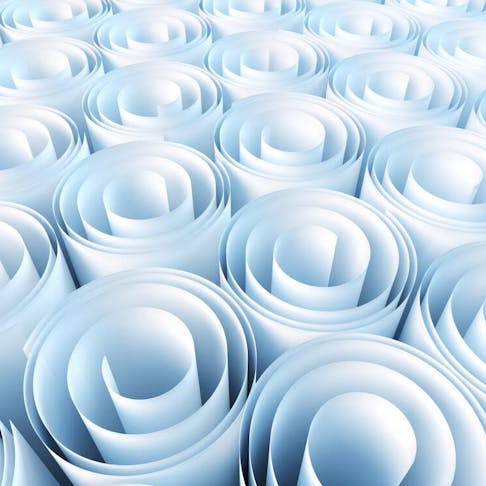Laminated Object Manufacturing (LOM) is an elegantly simple concept that builds prototypes out of cut sheet materials. Sheet materials are placed over the whole build table to selectively bond to the layer below and then cut, either with a laser or a traveling knife, to extract the 2D slice from the sheet. LOM originated with Helisys in 1991 and established a niche in the rapid manufacturing sector. Helisys was succeeded by Cubic Technologies.
LOM 3D printing made low-cost models that were easy to work with and surprisingly fast to build. It is limited in the scope of undercuts and shapes complexity, primarily by the difficulty of extracting the finished model from the waste material. It also requires thick walls (5 to 10 mm minimum) to produce models that offer any strength. Hollows and cavities were also difficult or impossible to clear waste, so models could be quite heavy for their size.
The primary parts of a LOM 3D printer are the build area, roller, and laser. This article will further discuss LOM 3D printing, how it works, its primary parts, the pros, and cons, as well as the materials used.
What is Laminated Object Manufacturing 3D Printing?
Laminated object manufacturing 3D printing is a versatile process that glues together layers of material (typically adhesive-coated plastic, metal, or paper) and cuts the layers to shape. The process results in a product that can be further processed either by machining or drilling. LOM is typically used for rapid prototyping due to it being a fast and inexpensive additive manufacturing process.
How Does Laminated Object Manufacturing 3D Printing Work?
Laminated object manufacturing works by layering sheet materials, which are cut in place by either a laser or a traveling knife. The 2D outline is then extracted as an outline of a slice before another layer is added. Sheets of materials are rolled out on a build platform and are coated with adhesive. The adhesive-bearing sheet is placed onto the build table, atop the laminate pile. Accurate positioning using relatively simple inkjet/photocopier paper-handling methods produces a rectilinear stack. The new laminate layer is then pressed into place with a hot roller to ensure good bonding and curing. Once the layer is cured, a scanning laser or traveling tungsten knife cuts the slice outline, leaving the waste material in place as support for the next laminate. Once all layers are applied and cut, the model is “extracted” from the waste manually, revealing a finished prototype.

| LOM Pros | LOM Cons |
|---|---|
LOM Pros Fast and inexpensive. It is typically used for rapid prototyping rather than production. | LOM Cons Models are very weak where wall sections are thinner than 10 mm. |
LOM Pros Models are produced from low-cost materials, and with the right choice of model and careful post-processing, good-quality outcomes, from a visual appeal perspective, are possible. | LOM Cons Only coarse-featured models can be produced to a high standard. |
LOM Pros No support materials or structures are required for the undercuts that can be reproduced (which are limited). As the waste material remains in place, forming a solid cuboid from which the part is extracted. | LOM Cons Most undercuts represent an extraction hazard, as the waste material will remain partially attached and excessive vigor in removing it will lead to cosmetic and structural damage. |
LOM Pros The equipment is very office friendly—no smells, little noise, and a small footprint. | LOM Cons No fine features can be reproduced without the most extreme care in waste extraction. |
LOM Pros
| LOM Cons Hollows are hard or impossible to clear waste material, making “packs” solid and very heavy. |
What Are the Materials Used in LOM 3D Printing?
The materials used in Helisys LOM 3D printing are adhesive pre-coated rolls of:
- Paper: White or colored
- Metal: Only aluminum proved practical
- Plastic: Various plastics were available
What Are the Primary Parts of a LOM 3D Printer?
The primary parts of a LOM 3D printer vary, depending on the model. For example, with Helisys LOM printers, the primary parts are:
- Roll feeder
- Build table
- Hot roller
- Scanning laser
What Are the Best LOM 3D Printing Resins?
LOM 3D printers can print a wide variety of polymer-based composites. Heat-activated adhesives on the underside of Helisys LOM materials offered high-temperature, hot-melt options, and heat-activated cross-linking resins. This allowed adhesives to be selected according to application and laminate material.
How is LOM 3D Printing Used in the Medical Industry?
LOM 3D printing is used in the medical industry for creating organ visualization models. Attempts were made to create functional parts for implants and for fracture stabilization.
How is LOM 3D Printing Used in the Jewelry Industry?
LOM printers have, at certain times, created prototypes for complex and particularly highly colored wearables.
Are LOM Printers Capable of Producing Massive, Detailed Pieces?
Yes, one large format LOM machine was made. The Envisiontech large format pre-preg fiber reinforced laminate machines had a huge build area, measured in feet!
Summary
This article presented laminated object manufacturing (LOM), explained what it is, and discussed how it's used in manufacturing. To learn more about laminated object manufacturing, contact a Xometry representative.
Xometry provides a wide range of manufacturing capabilities, including 3D printing and other value-added services for all of your prototyping and production needs. Visit our website to learn more or to request a free, no-obligation quote.
Disclaimer
The content appearing on this webpage is for informational purposes only. Xometry makes no representation or warranty of any kind, be it expressed or implied, as to the accuracy, completeness, or validity of the information. Any performance parameters, geometric tolerances, specific design features, quality and types of materials, or processes should not be inferred to represent what will be delivered by third-party suppliers or manufacturers through Xometry’s network. Buyers seeking quotes for parts are responsible for defining the specific requirements for those parts. Please refer to our terms and conditions for more information.

